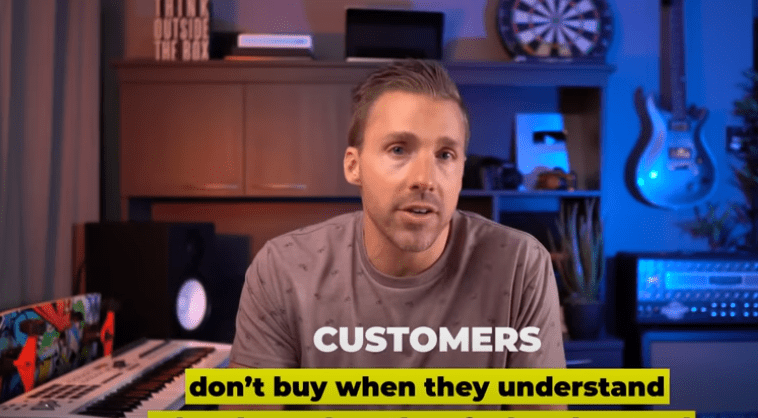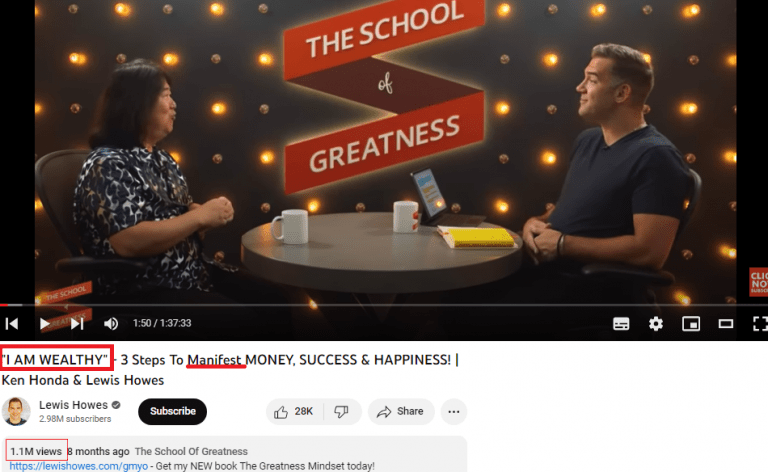5 Best Adam Erhart Marketing Lessons
Adam Erhart has established himself as one of the top authorities in digital marketing on YouTube.
You’ll find great, actionable advice for marketing across the videos on his channel.
But with over 776 videos on his channel, it can be hard to know where to start. Trying to watch all of his videos would take days.
So I’ve gone through his content myself and picked out five of the best marketing lessons from his videos.
These lessons are perfect for anyone who is new to marketing. Adam does a really good job explaining some of the fundamentals of marketing.
But they also serve as a great reminder of important concepts for those who are more experienced.
In this post, you’ll learn..
- Why having the best product or lowest price isn’t enough
- 7 free tools you can use for market research
- A proven Facebook ads formula you can copy (with an example)
- How you can easily create more content for social media
- 15 powerful psychological triggers you can use in your marketing
I’ve also included links to Adam’s relevant YouTube videos so you can check them out for more details.
1. Being Different Is Better Than Being Better
In his video titled Marketing 101, Erhart talks about the importance of being different.
If your business is trying to compete in a competitive market, you need to stand out by being different. Just being better than the competition isn’t enough.
Having the best quality product or the fastest delivery times isn’t always enough. All your competitors are saying the same things.
If customers can’t tell the difference between your business and your competitors, they will just go to whoever is offering the lowest prices. So you need a way to differentiate your business.
You want to develop a Unique Selling Proposition (USP) in your business. Consider what you offer that nobody else does.
2. Take Advantage Of Market Research Tools
A common theme in Adam’s marketing content is understanding your target market.
And to truly understand your target market, he emphasises the importance of market research.
Good market research will help answer key questions in your marketing like:
- Who you should target?
- How you should reach them?
- What do they care about?
In his video on market research, Eckhart recommends using free tools like Amazon, Think With Google and Google Trends for market research.
On Amazon, you can look at reviews on products similar to yours to get ideas on what customers like and dislike. Looking at the negative reviews can also give you insights into customers’ pain points.
Erhart also suggests looking at the question and answer section on Amazon and looking at the auto-suggest in Amazon’s search bar for ideas.
Aside from Amazon, there are plenty of other platforms you can use to get insights into your target market and what they’re saying.
I like looking at Google or Facebook reviews for other competitors in my industry. Online discussion forums like Reddit and Quora can be helpful. So can Facebook groups related to your industry.
3. Use This Facebook Ads Formula
According to Adam Erhart, the mechanics of setting up a Facebook Ad campaign are no longer as important as they once were.
In 2023, what’s really going to make a difference to the performance of your campaigns is the ad creative. This includes the images, videos and the ad copy you use in your ads.
To improve your conversion rates and costs, Adam recommends a four-part Facebook Ads copy formula to make your creative more effective:
- The hook – the purpose of the hook is to capture the attention of your target market. Using a question can be an effective way to achieve this.
People are automatically programmed to answer questions, especially if the question is relevant to them. - The problem – the next part of your ad copy should introduce the problem that your product will solve. This is an opportunity to get into your customer’s pain points.
- The solution – now that you’ve introduced the problem, you will introduce the solution – being your product.
You want to show how your product will bridge the gap between where they are now and where they want to be. - The Call To Action – this is the final part of the formula. Here you want to tell the reader exactly what step they should take next.
Here is an example of how an insurance broker could use the formula to promote life insurance:
[Hook]
Are your loved ones financially protected if something were to happen to you?
[The Problem]
Life is unpredictable, and unexpected events can leave your family vulnerable. Without proper life insurance coverage, they may struggle to meet financial obligations, such as mortgage payments, education expenses, or daily living costs.
[The Solution]
We offer customizable life insurance plans to fit your unique needs and budget. Our policies provide financial security, so your family is protected even in the face of life’s uncertainties. With our trusted insurance solutions, you can have peace of mind knowing that your family’s future is safeguarded.
[Call to Action]
Take the first step towards securing your family’s financial future today. Click the link below to get a free quote and find the perfect life insurance plan for you. Don’t delay, protect what matters most!
4. How To Get More Out Of Your Social Media Content
A few years back, repurposing content meant taking a blog post and pulling a few quotes from it to use on social media platforms.
But content repurposing has now evolved into a much wider scale.
The example that Adam Erhart gives in this video titled How To Effectively Promote Your Business In 2023, looks like this:
- Create a primary video: Create a video that addresses a specific topic or provides valuable information related to your business.
- Convert to a podcast: Extract the audio from the video and repurpose it as a podcast episode.
- Transcribe the video into a PDF: Use automatic transcription software to convert the video content into a written transcript. You might need to edit the transcript for accuracy.
- Create an online flipbook: You can use a platform like Issue to turn the PDF transcript into an immersive online flipbook.
- Take quotes for social media: Grab the best quotes or snippets from the video, podcast, or transcript. Then turn these quotes into bite-sized content pieces for sharing on social media platforms. Create captions, tweets, or social media graphics using the quotes and then publish them across your social media.
- Create short-form video: Take the best clips from the original video and repurpose them into short-form vertical videos. You can use the videos for platforms like YouTube Shorts, Facebook and Instagram Reels, and TikTok.
Repurposing content like this makes it easier to produce a high volume of content for your social media platforms. Since these platforms reward users for consistency, you can reach a wider audience.
5. Use These Psychological Triggers
Adam regularly emphasises the importance of understanding psychology in your marketing.
You need to understand the psychology of your target market and what makes them buy.
There are numerous psychological triggers, known as cognitive biases that can be used in sales and marketing.
In one video, Adam outlines 15 of these triggers. Those are..
- Halo effect: The first impression bias that influences future interactions with a brand or person.
- Serial position effect: The tendency to remember the first and last pieces of information more than those in the middle.
- Recency effect: Giving higher importance to the most recent information received.
- Mere exposure effect: The more familiar people are with something, the more they tend to like and trust it.
- Loss aversion: People have a fear of missing out and are motivated by scarcity or urgency.
- Compromise effect: People tend to choose a compromise option when faced with too many choices.
- Anchoring: The first piece of information or price seen becomes a mental anchor for evaluating subsequent options.
- Choice overload: Having too many choices can lead to decision paralysis or dissatisfaction.
- Framing effect: Positioning or framing offers or messages in a way that makes them more attractive to the target audience.
- IKEA effect: People value things more when they are involved in their creation.
- Pygmalion effect (Rosenthal Effect): High expectations lead to better performance and results.
- Confirmation bias: People tend to filter information in a way that confirms their existing beliefs.
- Peltzman effect (risk compensation theory): People prefer low or no-risk options.
- Bandwagon effect: People tend to follow what others do.
- Blind-spot bias: People are often unaware of the cognitive biases and psychological triggers influencing them.
If you want to see real examples of how these triggers are used in marketing, I’ve written numerous case studies of marketing campaigns that explain how these effects are used.
In this post, I explain how infamous MLM company inCruises uses the bandwagon effect and the framing effect in their marketing to recruit new members.
And in this post about John Crestani, I explain how he and other online marketing gurus use confirmation bias to appeal to their target audience. The article also explains how Crestani uses loss aversion in the form of scarcity to motivate people to act quickly.







